The meaning of bivalves
Class Bivalve refers exclusively to aquatic animals. Bivalves feed by filtration - they pump water through their mantle cavity and filter nutrients from her. This feature contributed to the formation of certain features of this class, for example, the structure of many organ systems in this class is significantly simplified compared to other classes of mollusks.
The name of the class is due to the fact that all types of mollusks of this class have bivalve shell. The closing and opening of the shell valves occurs with the help of contactors- special muscles. The shell valves are connected to each other by a special elastic ligament.
Typical representatives of the class Gastropods are pearl barley, toothless, mussels And oysters. Most major representative class is tridacna- sea clam , reaching a weight of 400 kg.
In fresh water bodies of our latitudes you can often find toothless. The toothless body, which can be found in the shell, consists of a leg and a torso. Body covered mantle, which hangs down on the sides in the form of two folds. Between these folds and the body a cavity is formed where the leg and gills are located. There is no head.
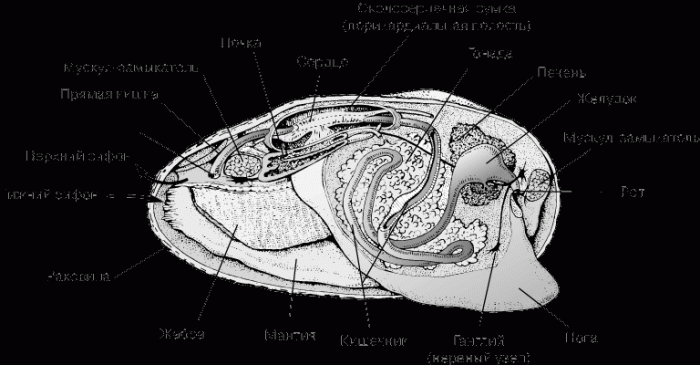
At the back of the body, two folds of the mantle join to form siphons- two holes through which water passes. Water enters through the lower siphon and exits through the upper siphon, washing gills. These organs are respiratory system bivalve mollusk.
Together with water, the gills filter out various particles: plant remains, unicellular algae and other organic and inorganic substances. These particles enter the mouth and then into stomach, where they begin to be digested under the action of enzymes produced by the liver. Liver the toothless is well developed, its ducts exit into stomach. After the stomach, food continues to be digested intestines. This is what it looks like digestive system toothless.
Toothless Reproduction is quite complex and interesting process. Fertilization of the egg occurs in the mantle cavity of the female, where sperm enter along with water through a siphon. Develops from a fertilized egg larva, which already at this stage of development has a bivalve shell with notches at the ends of the valves. The toothless larva develops on the skin or gills of the fish, forming a tumor in which the mollusk develops.
Bivalve mollusks are widely used by humans in industrial purposes. Mussels and oysters are eaten, while other species are used to harvest and grow pearls (such as barley or pearls).
Shellfish- multicellular, three-layered animals with bilateral body symmetry, having a mantle (large fold of skin) surrounding the base of the body.
Type There are about 130 thousand species of mollusks.
Modern scientists distinguish in the type Mollusks classes : pit-tailed, groove-bellied, armored (chitons), monoplacophorans, bivalves, spatulate, gastropods (snails), cephalopods (octopuses, squids, cuttlefish).
Malacology(from the Greek malakion - mollusk and logos - word, doctrine) - a section of zoology that studies mollusks.
Conchology(conchiliology) (from the Greek konche, konchylion - shell and logos - word, doctrine) - a branch of zoology that studies shells (mainly mollusks).
Features of the external structure
have a soft body enclosed in a shell
have a bilaterally symmetrical body structure, i.e. folded according to the principle of mirror reflection - the left half of the body completely corresponds to the right half. However, during ontogeny, some species experience displacement or uneven growth of organs, which leads to asymmetry. Asymmetry is especially pronounced among gastropods.
the body has no segmentation. Consists of three sections: head, legs, torso.
The torso contains all the major internal organs.
have a mantle - an epithelial fold that completely or partially covers the body, connects it with external environment. The mantle complex of organs is located in the mantle cavity: the excretory tract of the reproductive system, the excretory tract digestive system, ctenidium, osphradium and hypobranchial gland. The complex also includes the kidneys and pericardium.
the secondary cavity (as a whole) is represented by the cavity of the heart sac (pericardium) and the cavity of the gonads.
Peculiarities internal structure
|
Organ system |
Characteristic |
|
Digestive |
Unclosed. Consists of the pharynx, esophagus, stomach, midgut and hindgut (rectum). The hindgut opens through the anus into the mantle cavity. Most mollusks are characterized by the presence in the pharynx special apparatus for grinding food - radula. Power types: Filters – toothless, pearl barley. Herbivores - pond snails, coils. Predators: squid, octopus, cuttlefish. |
|
Blood |
Unclosed (with the exception of cephalopods). Consists of the heart (1,2, sometimes 4 atria and ventricle) and blood vessels. The color of the blood is bluish (due to hemocyanin, a copper-containing respiratory pigment). |
|
Respiratory |
Represented by gills and lungs. |
|
excretory |
Represented by kidneys (1 or 2). |
|
Hermaphrodite (snails) or dioecious (toothless). |
|
|
U lower groups– consists of a peripharyngeal ring and four trunks (tetraneural type of nervous system). In the higher ones, it consists of ganglia (3 or more pairs) and a well-developed suprapharyngeal ganglion (“brain”) - a scattered nodular type of nervous system. |
|
|
Sense organs |
Smell and taste are not separate. The organs of touch are scattered over the surface of the body - on the tentacles and mantle. |
|
Type of development |
Direct or indirect. The larvae are trochophore or swallowtail (veliger). |
Let's look at examples .
|
Bivalve |
Toothless mussels, pearl barley, oysters, mussels, tridacnas, pearl mussels, scallops, shipworms, geoducks. |
|
Gastropods (snails) |
Sea limpets, livebearers, helmet snails, abalones, grape snails, coils, pond snails, slugs, ambers and many others. etc. |
|
Cephalopods |
Octopuses ( common octopus, blue-ringed octopus), squid (common squid, giant squid – colossal squid), cuttlefish (common cuttlefish, Australian giant cuttlefish) and etc. |
Aromorphoses that contributed to the emergence of:
unsegmented body
the appearance of a complex fold - the mantle and mantle cavity
shell formation
Idioadaptations that contributed to biological progress:
appearance of the shell
the emergence of an apparatus for grinding food - the radula
the emergence of two forms of respiration - gill and pulmonary
high fertility
Life processes and lifestyle bivalves
Movement of water in the mantle cavity. Water enters one of the holes ( inlet siphon ), formed at the posterior end of the body by the edges of the mantle, and exits through another ( outlet siphon ). Gills and internal sides mantle folds are covered with cilia. It is they who, when in motion, create a continuous flow of water in the mantle cavity.
Nutrition. Together with water, those organic particles and microorganisms on which the animal feeds enter the mantle cavity. A current of water brings them to the mouth. Mollusks with this type of nutrition are called filterers . One oyster in an hour it can filter about 10 liters of water, purifying it from suspended organic particles.
Some drill hard rocks and wood (using the sharp teeth of a shell or dissolving the rock with the acid released). Shipworm damages the bottoms of ships and piers, boring long passages into them.
Besides already known bodies digestive system, many also have oral lobes that take part in catching food.
Breath. Toothless, pearl barley and most other mollusks living in water breathe oxygen dissolved in water using gills . Gas exchange occurs in the gills. Through the walls of the gill vessels, oxygen from the water enters the blood, and excess carbon dioxide from the blood is transferred to the water.
Variety of bivalves
Perlovitsa. Looks like toothless pearl barley has a more elongated and thick shell, the length of which can reach almost 15 cm. Thick pearl barley lives in small rivers on fast current. It has a thick-walled shell, colored yellow when young, which darkens over time and becomes black-brown or black. The pearlescent layer is very well developed. Therefore, pearl barley has industrial significance: mother-of-pearl buttons are made from its shells. 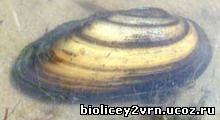
Sharovka(2)
.
Small bivalve mollusks are found in fresh water bodies, the length of their thin shell does not exceed 1.5 cm. They are called balls And peas. In peas, the top of the shell is shifted to the rear end, and in balls, it is located in the center of the shell. Many fish and birds readily feed on them. 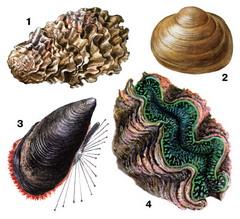
Oysters(1) . They live in sea water oysters. They grow with the lower (left) valve to the substrate. And they form continuous settlements - oyster banks. The average lifespan of an oyster is 5 years, the maximum is 30 years. The size of oysters varies depending on the species up to a maximum of 45 cm. Oysters have commercial value. You should know that they are capable of concentrating heavy metals that are dangerous to human health.
The meaning of bivalves
Bivalves constitute important links in the food chains of aquatic and even terrestrial biocenoses. Many fish, starfish, and land animals feed on them. Bivalves in aquatic biocenoses have great importance and as water filters.
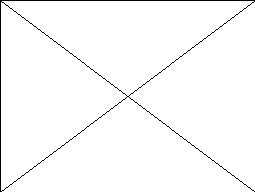
Man has been eating for a long time oysters, mussels (3) And scallops. These mollusks are often specially grown on special marine “farms”. They are considered a delicacy in many countries around the world.
Shells of species with a well-developed mother-of-pearl layer are used to make jewelry.
Digestive system. The mouth is located at the front end of the body above the base of the leg. On its sides there are two lobes covered with ciliated epithelium, the cilia of which push food particles towards the mouth. The short esophagus carries food into the small stomach, into which the liver ducts open. The intestine extending from the stomach forms a series of loops, rising to the dorsal side of the body, passing back through the pericardial sac and ventricle of the heart and opening into the cloacal siphon.
The integument of bivalves is rich in various glands that secrete mucus and other substances. So in stone-cutting mollusks (Pholas) the glands of the integument of the leg secrete acid that destroys lime, which allows the animal to go deeper into the calcareous rocks. In zebra mussels and mussels, the skin glands secrete a special substance - byssus, which hardens in water in the form of thin threads with which the mollusks are firmly attached to the substrate.
The mantle hangs from the sides in the form of two folds. They limit the mantle cavity, in which the gills and gills are located. The hindgut, renal ducts and reproductive tract open into the mantle cavity. Water enters it through the gill siphon and is removed through the cloacal siphon formed by the posterior edge of the mantle. The flow of water is created by the movement of cilia of the epithelium covering the mantle, gills and siphons.
The shell is formed by two valves connected at the top by an elastic ligament or lock - teeth located along the upper edge of the valves (Fig. 185, 186). In most species, both shell valves are the same, but in a number of mollusks lying on the bottom they differ in size and shape. The opening of the valves occurs automatically under the influence of the elastic properties of the connecting ligament. The convergence of the valves is caused by the contraction of powerful muscles - obturator muscles, connecting both valves. The growth of the shell occurs along the outer edge of the valves due to secretions from the glands of the underlying mantle. In winter, the growth of mollusks almost stops, which is why annual stripes are formed on the valves, by the number of which the age of the animal can be determined.

Having examined the structure of bivalves, we can conclude that this group of animalswell adapted to livingat the bottom.Bivalves are bilaterally symmetrical animals with a bodywhich consists of legs and torso.They have a shell of two valves,connected on the dorsal side by an elastic ligament. From inside the sashclose the closing muscles. Respiratory organs - gills. Bivalves are water filter feeders. In general, bivalves play a significant role in the life of the seas and oceans. Many are of industrial importance.
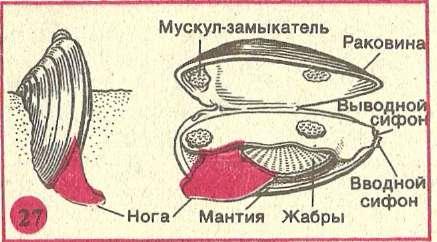
|
Invertebrates - shellfish- Marine bivalves |
|
|
Marine bivalves Application and properties These are edible inhabitants of the sea, containing enzymes, important trace elements and amino acids. It is worth noting that the mineral balance of these mollusks is very close to min-x substances Blood plasmas are in their natural chelated form, which improves their absorption in our body. These mollusks have a positive effect on the functioning of the lymphatic and cardiovascular systems, the organ of vision, endocrine organs, and improves the condition of the mucous membranes and connective tissue. They help relieve stiffness and pain from arthritis, reduce inflammation, and also help speed up the healing of burns and wounds.
PROPERTIES AND APPLICATION
It's edible maritime shellfish containing amino acids, enzymes and important microelements. It is important that the balance of mineral substances in the mollusk is close to the balance of mineral substances in the blood plasma and the minerals are in a natural chelated form, which improves their absorption in the body. These clams contribute to the normal functioning of the cardiovascular and lymphatic systems, endocrine organs, organ of vision, improves the condition of connective tissue and mucous membranes. They help reduce inflammation, relieve pain and stiffness from arthritis, and also speed up the healing of wounds and burns.
|
Invertebrates - shellfish- The meaning of bivalves |
|
|
Tridacna. Pearl mussels. Oysters. Scallops. Mussels
Bivalve- marine and freshwater molluscs, which are characterized by the absence of a head, the presence of a wedge-shaped burrowing leg and the presence of a shell consisting of two valves. In attached species the leg is reduced. Unattached species can move slowly by extending a leg and then pulling the whole body towards it.
The mantle, in the form of two folds of skin, hangs down the sides of the mollusk’s body. The outer epithelium of the mantle contains glands that form the shell valves. The substances in the valve are arranged in three layers: outer organic (conchiolin), calcareous and inner nacreous. On the dorsal side, the valves are connected by an elastic ligament (ligament) or lock. The valves close with the help of closing muscles. On the dorsal side, the mantle fuses with the body of the mollusk. In some species, the free edges of the mantle grow together, forming openings - siphons for the entry and exit of water from the mantle cavity. The lower siphon is called the introductory, or gill, siphon, the upper - the excretory, or cloacal.
In the mantle cavity on both sides of the leg there are respiratory organs - gills. The inner surface of the mantle and gills are covered with ciliated epithelium, the movement of the cilia of which creates a flow of water. Water enters the mantle cavity through the lower siphon and is discharged through the upper siphon.
According to the method of feeding, bivalves are filter feeders: food particles that enter the mantle cavity are glued together and sent to the mouth of the mollusk, located at the base of the leg. Food from the mouth enters the esophagus, which opens into the stomach. The midgut makes several bends at the base of the leg, then passes into the hindgut. The hindgut usually penetrates the ventricle of the heart and ends at the anus. The liver is large and surrounds the stomach on all sides. Bivalves, unlike gastropods, do not have a radula and salivary glands.
rice. 1.
A - side view, B - transverse section: 1 - pedal ganglion, 2 - mouth,
3 - anterior closing muscle, 4 - cerebropleural ganglion,
5 - stomach, 6 - liver, 7 - anterior aorta, 8 - pericardium, 9 - heart,
10 - atrium, 11 - ventricle, 12 - posterior aorta, 13 - kidney,
14 - hindgut, 15 - posterior adductor muscle, 16 - viscero-
parietal ganglion, 17 - anus, 18 - mantle,
19 - gills, 20 - gonad, 21 - midgut, 22 - leg,
23 - ligament, 24 - shell, 25 - mantle cavity.
The nervous system of bivalve mollusks is represented by three pairs of ganglia: 1) cerebropleural, 2) pedal and 3) viscero-parietal ganglia. The cerebropleural ganglia are located near the esophagus, the pedal ganglia are in the leg, and the visceroparietal ganglia are located under the posterior conchal closure muscle. Sense organs are poorly developed. The leg contains balance organs - statocysts, and at the base of the gills there are osphradia (chemical sense organs). Tactile receptors are scattered in the integument.
The circulatory system is of an open type and consists of the heart and blood vessels. The heart is three-chambered, has two atria and one ventricle. Blood from the ventricle exits into the anterior and posterior aortas, which split into small arteries, then the blood pours into the lacunae and is directed through the branchial vessels to the gills. Oxidized blood travels through the efferent gill vessels from each side of the body into its atrium and common ventricle.
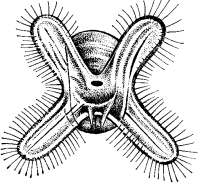
rice. 2. Bivalve larva
mollusks - veliger.
Excretory organs - two kidneys.
Bivalves are usually dioecious animals. Testes and ovaries are paired. The reproductive ducts open into the mantle cavity. Spermatozoa are “thrown out” by males through the excretory siphon into the water and are then drawn through the inlet siphon into the mantle cavity of the females, where fertilization of the eggs occurs.

rice. 3. Toothless larva
- glochidia:
1 - sashes, 2 - hooks,
3 - sticky (byssus).
In most species of bivalve mollusks, development occurs with metamorphosis. From fertilized eggs, the planktonic veliger larva, or swallowtail, develops (Fig. 2).
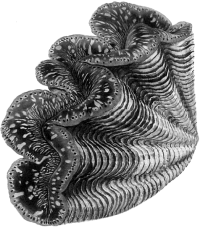
rice. 4. Tridacna
(Tridacna gigas).
Tridacna gigas- the largest species of bivalve mollusks (Fig. 4). The weight of tridacna reaches 250 kg, body length - 1.5 m. It lives in coral reefs Indian and Pacific Oceans. Unlike other bivalves, the heavy dorsal part of the tridacna shell rests on the ground. This orientation of the shell led to large changes in the arrangement of various organs; in general, we can say that Tridacna rotated 180° inside its shell. The only adductor muscle has shifted to the abdominal edge.
The edges of the mantle are greatly expanded and fused along almost the entire length, except for three areas where the openings of two siphons and the opening for the exit of byssal threads are located. In the thickened edge of the mantle live the single-celled algae zooxanthellae. Tridacna is a filter feeder, but can also feed on these zooxanthellae.
Tridacna shells and meat have been used by the peoples of Oceania for a long time.
Pearl mussels live in the Pacific and Indian Oceans at shallow depths (Fig. 5). They are hunted for the purpose of harvesting pearls. The most valuable pearls are produced by species of the genera Pinctada, Pteria.
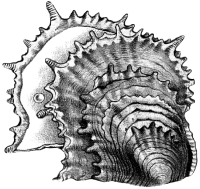
rice. 5. Pearl mussel
(Pinctada sp.).
A pearl is formed when a foreign body (a grain of sand, a small animal, etc.) gets between the mantle and the inner surface of the mantle. The mantle begins to secrete mother-of-pearl, which envelops this foreign body layer by layer, irritating it. The pearl increases in size, gradually detaches from the inner surface of the shell and then lies free. Often it doesn't connect to the sink to begin with. The pearl consists of alternating layers of nacre and conchiolin. 50-60 years after being removed from the mollusk, it becomes covered with cracks, this is due to the destruction of the conchiolin layers inside it. The maximum “life” of a pearl as jewelry does not exceed 150 years.
In order to have jewelry value, a pearl must have a certain size, shape, color, and purity. Pearls that meet “jewelry” requirements are rare in nature. At the end of the nineteenth century, a method of artificially growing pearls in sea pearl oysters was proposed. Mother-of-pearl balls turned on a lathe are tied with sections of the mantle sheets and in this form are transplanted into three-year-old mollusks. The aging period of a pearl sac (“kernel”) is from 1 to 7 years.
Currently, pearl farming technology is as follows. Some farms raise pearl mussels up to three years old, then transfer them to pearl farms. Here the pearl mussels are subjected to surgery (the “nuclei” are introduced) and then placed in special sieves, which are suspended from rafts. After a few years, the sieves are lifted and pearls are removed from the pearl oysters.
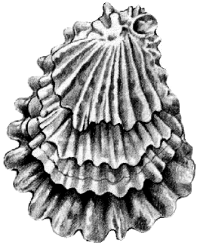
rice. 6. Oyster
(Crassostrea virginica).
Artificial breeding marine animals is called mariculture.
Oysters(Fig. 6) have been consumed by humans since time immemorial. The oyster shell is unequal: the left valve is larger in size than the right and more convex. The left valve of the mollusk is attached to the substrate. The mantle is open, does not form siphons, and the water flow is through. Well-developed semicircular gills surrounding a powerful adductor (adductor muscle). Adult mollusks lack a leg. Oysters are dioecious. Fertilized eggs develop in the posterior part of the female's mantle cavity. After a few days, the larvae enter the water, swim, settle and attach to the substrate. Oysters usually form clusters; a distinction is made between coastal settlements and oyster banks.
About 50 species of oysters are known, which belong to the families Ostreidae and Crassostreidae. One of the main commercial species is the edible oyster (Ostrea edulis). As a result of centuries of fishing, the number of oysters in many populations has sharply decreased. Currently, along with fishing in natural places habitats, oysters are grown artificially in specially organized oyster parks.
Specific conditions are required to grow oysters. First of all, they eat a certain type plankton. Secondly, they do not live at depths below 10 meters and at water temperatures below 5 °C. Plantations are usually laid out not very far from the coast in closed bays, so as not to be swept away by a storm. The period of growing oysters is not so short and is 34 years. Mollusks are kept in special containers, submerged to a certain depth and inaccessible to predators. After ripening, the oysters are placed in pools with clean water for a certain time. sea water and special algae.
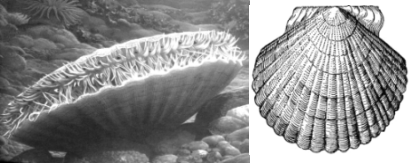
rice. 7.

rice. 8.
Scallops- several dozen species gastropods, which belong to the families Pectinidae and Propeamusiidae. Scallops have a rounded shell with a straight locking edge, which has angular projections in the form of ears in front and behind. The surface of the valves has radial or concentric ribs. The leg is rudimentary, has the appearance of a dense finger-like outgrowth. On the middle fold of the mantle there are numerous eyes and pallial tentacles with tactile receptors (Fig. 7). Unlike other types of bivalves, scallops can move by swimming, “slapping” their valves (Fig. 8). The slamming of the valves is ensured by the contraction of the fibers of the powerful adductor. Scallops are dioecious animals.
The adductor of scallops and sometimes their mantle are used as food. Just like oysters, scallops are not only caught in natural habitats, but also grown artificially (Patinopecten yessoensis). First, rafts are installed in a fenced area of the sea, from which collectors (pallets, panicles, etc.) are suspended. The larvae of mollusks settle on these trays. After 1-2 years, young mollusks are removed from the collectors, placed in individual nets and raised on “farms”.
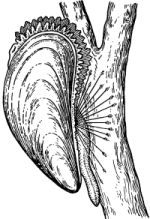
rice. 9. Edible mussel
(Mytilus edulis).
Mussels- several species belonging to the Mytilidae family. They lead an attached lifestyle, due to which the leg is reduced, loses the ability to move and serves to secrete byssal threads. The shell has a characteristic “mytilid” shape, a very dark color, often blue-black. The length of the shell of the edible mussel (Mytilus edulis) is about 7 cm, height - up to 3.5 cm, thickness - 3.5 cm. The posterior adductor is much larger than the anterior one. Mussels are dioecious animals. Mussel colonies are a powerful biofilter that purifies and brightens water. It is estimated that mussels settling on 1 m 2 of the bottom filter up to 280 m 3 of water per day.
Mussels are used as food. Fishing for these mollusks has been going on since ancient times. In addition, mussels are currently grown artificially. In this case, approximately the same technology is used as when growing scallops.
rice. 10. Teredo
(Teredo navalis):
1 - sink,
2 - body,
3 - siphons,
4 - moves, drilled
caught by molluscs.
Teredo(Fig. 10) belongs to the Woodworm family (Teredinidae). The body shape is worm-like, so these mollusks have another name - ship worms. The body length is up to 15 cm; at its anterior end there is a shell, reduced to two small plates. The sink is “equipped” with a drilling apparatus. At the posterior end of the body there are long siphons. Hermaphrodites. In wooden underwater objects, the teredo “drills” numerous passages and feeds on wooden “crumbs”. Digestion of wood is carried out by symbiotic bacteria. As a result of the activity of shipworms, the tree becomes like a sponge and is easily destroyed. Teredos pose a danger to wooden ships and buildings.
Bivalve - marine and freshwater molluscs, which are characterized by the absence of a head, the presence of a wedge-shaped burrowing leg and the presence of a shell consisting of two valves. In attached species the leg is reduced. Unattached species can move slowly by extending a leg and then pulling the whole body towards it. The mantle, in the form of two folds of skin, hangs down the sides of the mollusk’s body. The outer epithelium of the mantle contains glands that form the shell valves. The substances in the valve are arranged in three layers: outer organic (conchiolin), calcareous and inner nacreous. On the dorsal side, the valves are connected by an elastic ligament (ligament) or lock. The valves close with the help of closing muscles. On the dorsal side, the mantle fuses with the body of the mollusk. In some species, the free edges of the mantle grow together, forming openings - siphons for the entry and exit of water from the mantle cavity. The lower siphon is called the introductory, or gill, siphon, the upper - the excretory, or cloacal. In the mantle cavity on both sides of the leg there are respiratory organs - gills. The inner surface of the mantle and gills are covered with ciliated epithelium, the movement of the cilia of which creates a flow of water. Water enters the mantle cavity through the lower siphon and is discharged through the upper siphon. According to the method of feeding, bivalves are filter feeders: food particles that enter the mantle cavity are glued together and sent to the mouth of the mollusk, located at the base of the leg. Food from the mouth enters the esophagus, which opens into the stomach. The midgut makes several bends at the base of the leg, then passes into the hindgut. The hindgut usually penetrates the ventricle of the heart and ends at the anus. The liver is large and surrounds the stomach on all sides. Bivalves, unlike gastropods, do not have a radula or salivary glands. The circulatory system is an open type, consisting of the heart and blood vessels. The heart is three-chambered, has two atria and one ventricle. Bivalves are usually dioecious animals. Testes and ovaries are paired. The reproductive ducts open into the mantle cavity. Spermatozoa are “thrown out” by males through the excretory siphon into the water and are then drawn through the inlet siphon into the mantle cavity of the females, where fertilization of the eggs occurs. Representatives: Pearl mussels live in the Pacific and Indian oceans at shallow depths. They are hunted for the purpose of harvesting pearls. The most valuable pearls are produced by species of the genera Pinctada, Pteria. The oyster shell is unequal: the left valve is larger in size than the right and more convex. The left valve of the mollusk is attached to the substrate. Scallops have a rounded shell with a straight locking edge, which has angular projections in the form of ears in front and behind. The surface of the valves has radial or concentric ribs. Mussels are used as food. Fishing for these mollusks has been going on since ancient times.
38. Cl. Cephalopods. Features of structure, life activity. Representatives.
Body cephalopods bilaterally symmetrical, divided into head and trunk. The leg transformed into tentacles and a funnel. The shell in primitive forms is external, multi-chambered (Nautilus pompilius), while in higher representatives it is internal, reduced, and often absent. On the head there is a mouth surrounded by tentacles and large eyes. The tentacles of most species have suckers. The integument is represented by a single-layer epithelium and a layer of connective tissue. The skin contains pigment cells - chromatophores, thanks to which cephalopods can quickly change body color. The anal, genital and excretory openings open into the mantle cavity, located on the abdominal side. To quickly move, cephalopods use a reactive method: with the help of strong muscle contractions, they throw water through a funnel from the mantle cavity, the recoil pushes the body into the opposite side. Cephalopods are predators. They feed on fish, crustaceans, mollusks, etc. The respiratory organs are represented by real gills (ctenidia), located in the mantle cavity on the sides of the body. IN circulatory system there is a heart consisting of a ventricle and atria (two or four), in addition there are two so-called “gill hearts”, which, contracting rhythmically, push blood through the gills. Oxidized blood returns to the heart. The blood contains the respiratory pigment hemocyanin, which contains copper. When oxidized, such blood turns blue. The excretory system consists of two or four kidneys. Their inner ends open into the pericardium, and their outer openings into the mantle cavity. Cephalopods are dioecious. Fertilization occurs in the female's mantle cavity. Development is direct. In some species, care for the offspring takes place. The class Cephalopods is divided into two subclasses: Nautilids, Coleoids. Nautilids – ancient group cephalopods, known since the Cambrian period. Found in tropical regions of the Indian and Pacific oceans. Nautilids have an external multi-chambered shell, numerous tentacles without suckers, four gills, four kidneys and four atria. Modern nautilids include one order Nautilida, represented by unique gender Nautilus. The pearl ship (Nautilus pompilus) (see figure) has an outer spirally twisted shell, divided into chambers. The body of the mollusk is placed in the last chamber, which opens with its mouth outward. The remaining chambers are filled with gas and chamber liquid. A siphon passes through the holes in the partitions between the chambers, the cells of which are capable of releasing gases. Coleoidea: Cuttlefish live in the coastal waters of tropical and subtropical seas. They have 10 tentacles, two of which are noticeably longer than the others and are hunting.
Class Bivalves (Bivalvia)
The class of bivalves includes exclusively aquatic, sedentary bottom mollusks with a bivalve shell that completely covers their body. The class includes more than 20 thousand species. In terms of the number of species, bivalves are several times inferior to the species diversity of gastropods, but in terms of numbers and biomass per unit area of the seabed, they have no equal. They are capable of aggregation and form mass accumulations. Bivalves mainly belong to the group of biofilters that feed on particles of organic matter suspended in water and small plankton, and therefore play a significant role in the biological purification of water. Most species have highly developed lamellar gills, which perform not only a respiratory, but also a filtering function. Therefore, this class also has a second name - Lamellibranchia. Due to passive movement and nutrition, the head of bivalves was reduced. All features of their external and internal structure reflect their ecological specialization for a sedentary or stationary lifestyle.
Bivalve species include commercial mollusks that are widespread in the seas: mussels, oysters, scallops, and corsets (Fig. 217). IN fresh waters often found: toothless, pearled mussels, balls, zebra mussels (Fig. 218). Bivalves are of great commercial importance. People use them for food and as raw materials. In addition, they provide valuable food for fish and other animals.
Rice. 217. Marine commercial bivalve molluscs (from Natalie): A - mussel Mytilus edulus, B - oyster Ostrea sublamellosa, C - heartfish Cardium edule, D - scallop Pecten islandicus
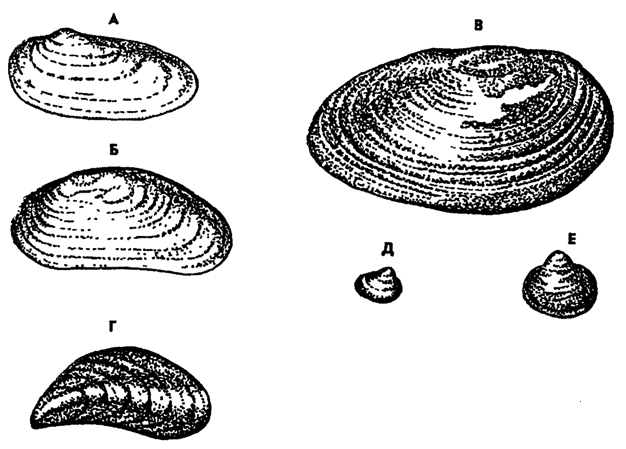
Rice. 218. Freshwater bivalves (from Natalie): A - pearl mussel Unio pictorum, B - freshwater pearl mussel Margantifera margantifera, C - toothless mussel Anodonta cygnea, D - zebra mussel Dreissena polymorpha, D - pea Pisidium amnicum, E - ball mussel Sphaenum corneum
External structure. Bivalves are characterized by having a shell with two valves, a wedge-shaped burrowing foot, and the absence of a head. In stationary forms the leg is reduced.
The shape and size of bivalve shells vary greatly. The shells of the smallest deep-sea bivalves do not exceed 2-3 mm in length. A giant among mollusks, Tridacna, which lives in tropical seas, can reach 1.4 m in length, and its weight can be up to 200 kg. The shell valves are often symmetrical, like those of cordates, and toothless. In some species, valve asymmetry may be observed. So, in an oyster, the lower, left valve, on which it lies, is convex (the entire body of the mollusk is located in it), and the upper, right valve is flat, covers the lower one and plays the role of a lid. A similar asymmetry of the shell valves is also observed in the scallop (Pecten) lying on the bottom. An even more pronounced asymmetry of the valves is observed in fossil forms of mollusks - rudists, in which one of the valves, immersed in the ground, is cone-shaped, and the other is flat in the shape of a lid (Fig. 219).
The walls of the shell usually consist of three layers: the outer - conchiolin (periostracum), the inner - calcareous (ostracum) and the lower - mother-of-pearl (hypostracum, Fig. 220). The shell is secreted by the mantle. The growth of the shell is carried out by the edge of the mantle. Concentric lines are visible on the shell, reflecting its uneven growth in changing environmental conditions. The conchiolin layer has a variety of patronizing connotation. At the tops of the valves this layer is often erased. The inner nacreous layer consists of small flat calcareous plates connected by conchiolin. This structure of mother-of-pearl causes interference of light, as a result of which the mother-of-pearl layer shimmers with all the colors of the rainbow. If any foreign particle gets between the mantle and the shell valve, it is enveloped in concentric layers of nacre and a pearl is formed (Fig. 221). The nacre layer thickens as the mollusk ages and its shell grows.
The shell valves are connected on the dorsal side by a ligament - a ligament consisting of a thickened stratum corneum of the shell. This indicates that the bivalve shell is of solid origin. Most species have a lock on the shell valves. These are teeth and depressions on the dorsal edge of the shell from the inner surface (Fig. 222). The lock teeth of one door fit into the corresponding recesses of the other and thereby prevent the doors from moving. The lock can be equal-toothed (taxodont) or heterodont (heterodont, Fig. 222). In some bivalves the lock is reduced (toothless - Anodonta). The shell valves of a living mollusk can open and close. Closing muscles (one or two) are used for this purpose. These are thick bundles of muscles connecting both valves. When they are reduced
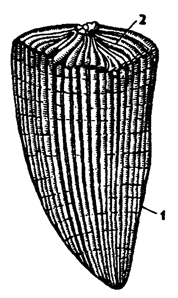
Rice. 219. Shell of the fossil bivalve mollusk Hippurites (from Tsitell): 1, 2 - asymmetric shell valves
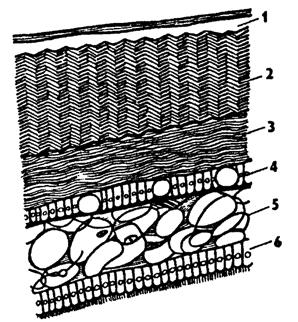

Rice. 221. Scheme of pearl formation: A. B, C - successive stages, D - section through the pearl; 1 - nacreous layer, 2 - mantle epithelium, 3 - connective tissue, 4 - foreign body, 5 - mantle sac, 6 - pearl, 7 - layers of nacre, 8 - core, 9 - conchiolin layers, 10 - prismatic layers
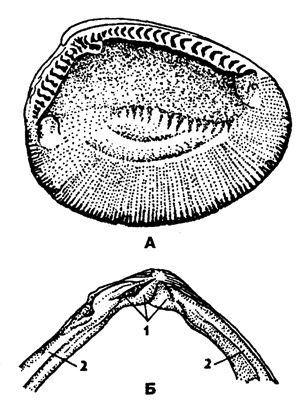
The doors close and open when relaxed. The mechanism for opening the valves is facilitated by a ligament, which, in the closed shell position, is in a tense state, like a spring, and when the closing muscles relax, it returns to its original position, opening the valves. In some cases, the shell may be reduced. Thus, in the wood-boring mollusk (Teredo), the shell covers only 1/20 of the body and is a drilling apparatus.
The wedge-shaped leg is used for burrowing into the ground and slow crawling. Some forms attached to the substrate have a special byssal gland in the leg, which secretes byssal threads, with the help of which they seem to grow to the hard surface of the bottom (mussel). In many immobile forms the leg is completely reduced (oyster).
Mantle and mantle cavity. The mantle has the shape of two folds of skin hanging from the back on the sides to the ventral side. The outer layer of the mantle is glandular and secretes a shell. The inner surface of the mantle is covered with ciliated epithelium, the movement of the cilia of which ensures the flow of water in the mantle cavity. From below, the folds of the mantle can be free, like those of a toothless fish, or they can grow together, forming only openings for the legs in the front and rear openings of the siphons.
In burrowing forms, the siphons formed by the mantle are long, in the form of two tubes protruding from the ground. Water enters the mantle cavity through the lower, inlet siphon, and exits through the upper, outlet siphon. Water brings food particles and oxygen into the mantle cavity of the mollusk. The mantle complex of organs includes: a leg, two gills, two oral lobes, osphradia and openings of the digestive, reproductive and excretory organ systems (Fig. 223).
Digestive system bivalves are distinguished by their originality due to the passive method of nutrition by filtration (Fig. 224). They have a filter apparatus. Water entering through the inlet siphon into the mantle cavity is directed to the anterior end of the body, washing the gills and oral lobes. The movement of water in the mantle cavity is ensured by the ciliated epithelium covering the gills, oral lobes and the inner surface of the mantle. On the gills and oral lobes there are receptor cells (taste organs) and ciliary grooves, through which small particles of food, sorted from mineral particles, are transported to the mouth. The mouth is located in the front of the body near the anterior adductor muscle. From the mouth, food enters the esophagus, then into the endodermal stomach. Pharynx, radula and salivary glands due to the reduction of the head in bivalves, they are absent. The ducts of the bilobed liver flow into the stomach. In addition, the stomach has a crystalline stalk that secretes digestive enzymes. The midgut departs from the stomach, which then passes into the hindgut, which opens through the anus into the mantle cavity.
The hindgut of bivalves usually penetrates the ventricle of the heart. Excrement from the mantle cavity is thrown out through the excretory siphon by a current of water.
Nervous system bivalves are simplified in comparison with gastropods. Due to the reduction of the pharynx, the cerebral ganglia merged with the pleural ganglia and cerebropleural double nodes were formed (Fig. 225). The leg contains pedal ganglia, connected by connectives to the first pair of nodes. At the posterior end of the body, under the posterior adductor muscle, there is a third pair of nodes - visceroparietal, which innervate the internal organs, gills and osphradia
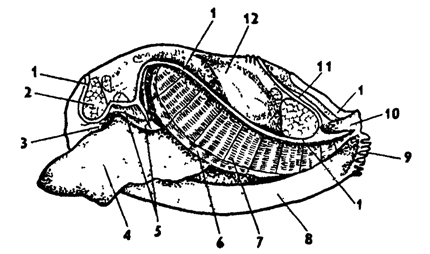
Rice. 223. Mantle cavity of the toothless Anodonta cygnea (according to Gaues): 1 - line along which the mantle is cut, 2 - anterior adductor muscle, 3 - mouth, 4 - leg, 5 - oral lobes, 6 - left internal hemibranch, 7 - left external semigill, 6 - right fold of the mantle, 9 - inlet siphon, 10 - outlet siphon, 11 - hindgut, 12 - pericardium

Rice. 225. Scheme of the nervous system of bivalve mollusks (according to Hesse): 1 - cerebral ganglia, 2 - pleural ganglia, 3 - pedal ganglia, 4 - visceroparietal ganglia
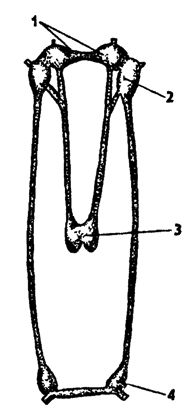
Rice. 224. Scheme of the internal structure of bivalve mollusks (according to Reman): 1 - mouth, 2 - anterior closing muscle, 3 - cerebropleural ganglion, 4 - stomach, 5 - liver, 6 - anterior aorta, 7 - external opening of the kidney, 8 - kidney , 9 - heart, 10 - pericardium, 11 - posterior aorta, 12 - hindgut, 13 - posterior adductor muscle, 14 - anus, 15 - visceroparietal ganglion, 16 - gills, 17 - gonadal opening, 18 - midgut, 19 - gonad, 20 - pedal ganglion
Sense organs poorly developed. The leg contains statocysts - organs of balance innervated by the cerebral ganglia. At the base of the gills there are osphradia - chemical sense organs. Receptor cells are located on the gills, oral lobes, edges of the mantle and on siphons. There are cases of the formation of eyes along the edge of the mantle in scallops or on the siphons in corsets.
Respiratory system represented by ctenidia - gills. Within the class of bivalves, the gill apparatus varies (Fig. 226). The most primitive bivalves, the protobranchia (Protobranchia), have a pair of typical ctenidia with feathery petals. Gills (Autobranchia) may have filamentous or plate-like gills. Filamentous gills are characterized by the fact that their gill filaments have elongated into filaments that fall into the lower part of the mantle cavity and then curl upward. In this case, adjacent threads are fastened to each other with the help of hard cilia, forming plates. Thread-like gills are characteristic of mussels, oysters, and scallops. Lamellar gills have an even more complex structure. They represent a further modification of the filamentous gills. They develop transverse partitions between the ascending and descending sections of the threads and between adjacent threads. This leads to the formation of gill plates. Each gill consists of two plates - outer and inner. The outer hemigill is adjacent to the mantle, and the inner one is adjacent to the leg. Such gills are typical for barnacles and barleys. And finally, in septibranchia, the gills are reduced and transformed into a gill septum with pores. The partition fences off top part mantle cavity, which performs the respiratory function. The walls of this

The respiratory cavities have a dense network of blood vessels where gas exchange occurs. The morphological series of gills - from ctenidia to filamentous and lamellar gills - reflects the main evolutionary trend in changes in the respiratory organs of bivalves.
Circulatory system(Fig. 227). The bicuspid heart is located on the dorsal side and consists of one ventricle and two atria. The hindgut passes through the ventricle of the heart. This is explained by the fact that the heart is formed in embryogenesis as a pair on the sides of the intestine, and then these rudiments are connected above and below the intestine. The paired origin of the heart in bivalves is confirmed by the presence of two hearts in the Area mollusk. Blood circulates through vessels and lacunae. The anterior and posterior aortas depart from the ventricle, branching into arteries from which the blood passes into the lacunae. Venous blood from internal organs gathers into a large longitudinal lacuna under the heart. From the lacuna the blood passes into the afferent gill vessels. Oxidized arterial blood from the gills returns to the heart through the efferent vessels. Part of the blood, bypassing the gills, passes through the kidneys, freeing itself from metabolic products, and flows into the efferent gill vessels, which flow into the atrium.
Excretory organs- kidneys, typical for all mollusks. The kidneys of bivalves with glandular walls are called boyanus organs. They are V-shaped and open at one end into the pericardium and at the other into the mantle cavity. Additionally, the excretory function is performed by the pericardial wall, modified in the form of paired glands - Keberian organs.
Reproductive system. Bivalves are dioecious. Paired gonads lie in the front of the body and at the base of the legs. Some species do not have reproductive ducts and the germ cells exit the gonads through tissue breaks into the mantle cavity. But there may also be paired reproductive ducts (oviducts or vas deferens), opening with genital openings into the mantle cavity. Fertilization is external. Male reproductive cells from the mantle cavity of males exit through the siphon, and then are drawn into the mantle cavity of females by a current of water.

Rice. 227. Cross section of a bivalve mollusk (from Hadorn): 1 - ligament, 2 - ventricle of the heart, 3 - coelom, 4 - atrium, 5 - mantle, 6 - mantle cavity, 7 - leg, 8 - gills, 9 - shell, 10 - kidney, 11 - intestine
where fertilization of eggs occurs. Such fertilization is possible only in close aggregations of mollusks.
Bivalvia class, according to modern system, is divided into three superorders: the superorder Protobranchia, the superorder Gill (Autobranchia) and the superorder Septibranchia.
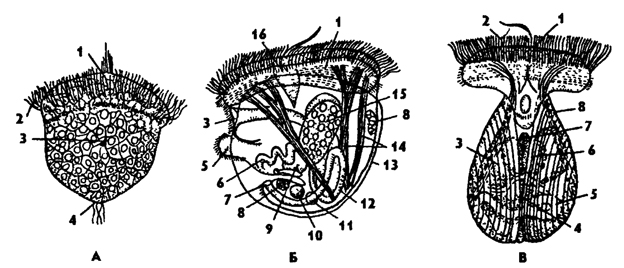
Rice. 228. Development of the zebra mussel Dreissena polymorpha (according to McBride): A - trochophore, B - veliger from the side, C - veliger from the front; 1 - plume of eyelashes, 2 - prototroch, 3 - mouth, 4 - posterior plume of eyelashes, 5 - leg, 6 - gill rudiment, 7 - anus, 8 - adductor muscle, 9 - pedal ganglion, 10 - visceral ganglion, 11 - heart rudiment, 12 - midgut, 13 - shell valve, 14 - muscle cords, 15 - liver, 16 - sail
Superorder Protobranchia. Includes the most primitive bivalves. Many of them are characterized by the primitive structure of their gills, which are represented by paired feathery ctenidia. The shell clasp is multi-dentate and taxodont. The teeth of the lock are approximately the same in shape, their number increases as the shell grows. The leg is wedge-shaped, with a small sole, without a byssal gland. There are statocysts in the leg open type. The pleural ganglia are separate from the cerebral ganglia. They live mainly in northern seas. Most species are ground-feeders. Their oral lobes are large and long appendages with which they collect detritus.
Protobranchia include small forms of marine bivalves, for example Nuculana, Goldia. The most common species is Nuculana pernula, which forms dense settlements (Fig. 230).
Superorder Gills (Autobranchia). This is the most numerous superorder of bivalves in terms of the number of species with their typical gills - modified ctenidia with filamentous gill filaments forming ascending and descending knees. The filaments on each side of the gill form one hemigill, and therefore there are four lamellar semigills in the mantle cavity. The threads of each semi-gill can be free and connected to each other only by bristles - these are filamentous gills.
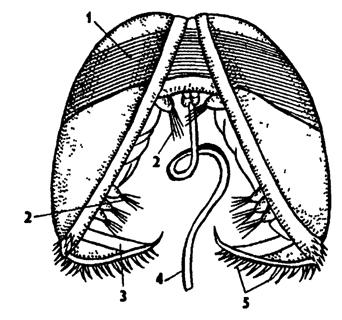
Rice. 229. Glochidium of the toothless Anodonta celensis (according to Herbers): 1 - adductor muscle, 2 - sensory setae, 3 - shell tooth, 4 - byssal filament, 5 - marginal denticles on the shell tooth
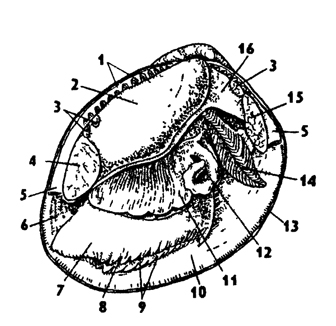
Rice. 230. Protobranchial mollusk Nuculana pernula (according to Ivanov): 1 - outgrowths of the mantle, 2 - trunk, 3 - leg muscles, 4 - anterior adductor muscle, 5 - part of the cut left mantle, 6 - mouth, 7 - leg, 8 - sole legs, 9 - papillae of the leg, 10 - right mantle, 11 - oral lobes, 12 - appendages of the oral lobes, 13 - mantle muscles, 14 - left ctenidium, 15 - posterior adductor muscle, 16 - mucous mantle gland
if the filaments of the semigills are interconnected by numerous transverse bridges, these are lamellar gills. There are morphological transitions between these types of gills. In addition to the respiratory function, the gills act as a filter for straining out food particles. Locks vary in shape, some forms are reduced. The leg is wedge-shaped and sometimes reduced. By type of nutrition - filter feeders.
The superorder Gilliaceae includes eight orders and more than 100 families of marine and freshwater bivalves. Let us consider some orders and families that reflect the ecological diversity of the superorder and have the greatest practical significance.
Order Unionida. These are freshwater bivalves leading a predominantly burrowing lifestyle (Fig. 218). Sink with heterodont lock or without lock. The leg is wedge-shaped, without byssus. The gills are lamellar. Development with the larva - glochidium or direct. The most common bivalves found in rivers are the toothless bivalves (Anodonta) and pearl barley (Unio). In the rivers of northern Eurasia, freshwater pearl mussels (Margaritifera) are common, and on Far East large combs - cristaria (Cristaria). In some countries, unionid is used as food, especially for fattening animals. Unionid shells used to be used to make linen buttons. The family of freshwater pearl mussels (Margaritiferidae), which are capable of producing pearls, is of greatest practical importance. It has long been mined in Russia European pearl mussel(Margaritifera margaritifera) to produce pearls. This species has been exterminated by predators and is listed in the Red Book. In total, there are over 20 genera of pearl mussels living in Eurasia and North America. Among the unionidae family there are commercial species of feathers and toothless ones with beautiful nacre. These include combs (Cristaria), the shell of which reaches 34 cm. Mother-of-pearl products are made from combs in China, Japan, and Indochina.
Order Mytilida. Mostly marine bivalves leading a sedentary or attached lifestyle. The least specialized among them is the arch family (Arcidae). The arches have symmetrical doors with an even-toothed lock. The leg is well developed and equipped with a special suction cup for attachment. Mostly motionless. More specialized families include non-motile oysters (Ostreidae) and mussels (Mytilidae). Along with arches, oysters and mussels are among the most important commercial species of shellfish used for food. Oysters have an asymmetrical shell. They have one adductor muscle, no lock, thread-like gills, and no leg. About 50 species of oysters are known. Their global production reaches several tens of thousands of tons per year. There are many oyster farms
banks where oysters are bred. Mussels have a shell with symmetrical valves with blue-violet mother-of-pearl. The mussels have a small foot with a byssal gland. Mussels are attached to the bottom using byssal threads. Of the closing muscles, the anterior muscle is smaller than the posterior one. The gills are filamentous. Global production of mussels per year is about 250 thousand tons.
Mussels and oysters are effective biofilters that are essential in the biological purification of water.
Mytilids also include stone cutters from the family of sea dates (Lithophagidae), close to mussels. They make passages in limestone using the acidic secretion of the mantle gland and attach to the walls of the passages with byssus, exposing their siphons. The most widely known is the Mediterranean lithophaga (Lithophaga lithophaga). Stone burrowers may provide evidence of secular fluctuations in sea level.
A special suborder consists of sea pearl mussels (Pteriina). The best pearls are produced by Pinctada and Pteria. Their shells are large, with thick mother-of-pearl, and a straight interlocking edge. These immobile mollusks are attached to the bottom using a byssus.
Order Pectinida. Pectinids include a number of families, among which the central family is the scallop family (Pectinidae). These are large mollusks with asymmetrical shell valves. The locking edge is straight, with angular projections. The outer edge of the shell has radial ribs. The leg is vestigial. One adductor muscle is developed. The scallop can swim short distances by contracting the adductor muscle and flapping the valves. When the valves slam shut, water is pushed out of the sink and the comb acquires a reactive movement. There are many commercial species among scallops. In the Far East, Patinopecten yessoensis is eaten.
Order Lucinida. These are inhabitants of seas and fresh waters. This includes about 30 families, of which the pea family (Pisidiidae) and the ball family (Euperidae) are often found in fresh waters. These are small bivalves with direct development. Their eggs develop in brood chambers on the internal gills.
Order of Venerida. The most extensive order of bivalves, including about 40 families. This includes the largest bivalves of the tridacnidae family. Among them, the largest species is Tridacna gigas from the Indo-Pacific region. Tridacnidus lie on their dorsal side with their valves open upward. There is only one closing muscle. In the thickened edge of the mantle of tridacnids live symbiotic algae - zooxanthellae, which they partially digest. The families Cardiidae and Veneridae are large groups of marine warm-water bivalves. The shape of the heart-shaped shell resembles
heart. The castle is well developed. The leg is long, and with its help the heartworms bury themselves and even jump, escaping from enemies. Hearts and venerids are edible. Large species are commercial.
Representatives of the zebra mussel family (Dreissenidae) are found in fresh and brackish waters. Dreissena shells are similar in appearance to mussels and are also attached to the substrate using a byssus. However, they differ in their structure. The most widespread is Dreissena polymorpha, found in rivers, as well as in desalinated areas of the Black and Caspian Seas. They form dense settlements and often cause harm by clogging watercourses and pipes.
Among the Veneridae there are the ecologically deviant family of stone borers - Pholadidae (Pholadidae) and the family of wood borers (Teredinidae). They have a drilling apparatus on the sink and long siphons. Foladas are fairly large mollusks, up to 12 cm in length. They damage limestone, sandstone and even concrete. Woodworms have a worm-like body, which is why they are called “ship worms.” They have a small shell at the anterior end of their body, and long siphons at the posterior end. There are five species of wood borers in our seas. In the Black Sea, Teredo navalis is the most common (Fig. 231).
Superorder Septibranchia. These are small marine, mostly deep-sea mollusks. A typical representative is Cuspidaria. Instead of gills modified into septa, they have suprabranchial sections of the mantle cavity. A sink with a retracted rear end from which siphons protrude. The castle has been reduced. The leg is wedge-shaped, with a groove. Mostly predators.
Practical significance of bivalves
Commercial significance. Since ancient times, people living along the shores of seas and rivers have used bivalves as food for themselves and their pets, and their shells were used to make household utensils and jewelry. Archaeologists find remains of mollusks at ancient human sites. With the growth of the population on Earth and with the development technical methods production
shellfish on minesweepers, the volume of world production of shellfish initially increased continuously. For example, in 1962, the world production of bivalves was 17 million c. (50% of all marine invertebrates produced), and then their production began to fall sharply. This stimulated the growth and development of bivalve mollusc mariculture. Mariculture is the artificial breeding of marine animals, which has a history of thousands of years. The cultivation of mussels and oysters has achieved especially great success in the USA, Japan and European countries - France, Spain, Italy. We have similar farms on the banks of the Black, White, Barents and Japanese seas. In oyster nurseries, sexually mature female mollusks are placed in small artificial sea pools, where the removal of their reproductive products is stimulated by increasing the water temperature. Fertilized eggs are transferred to conical containers where oyster larvae develop. The larvae are sorted using sieves and the largest ones are released into a pool in which the temperature is maintained above 20°C. At the same time, a culture of unicellular algae is constantly supplied to the pool for their nutrition. Finally, the larvae, ready to settle, are transferred to tanks with clean oyster shells or special boxes, where the formation of young oysters occurs.
But in Lately oyster, mussel and scallop plants use simpler technology. In a fenced area of the sea, rafts are installed, from which collectors (ropes, panicles, pallets) are suspended, on which mollusk larvae settle and grow to marketable size in 2-3 years. Scallops are usually removed from the collectors and raised in individual nets immersed in the sea. However, on such farms it is impossible to carry out selection of mollusks, as in nurseries of the first type. In our country in last years The cultivation of mussels has been established, from which canned food is made, while production waste is used as animal feed, and the shells are used as fertilizer.
Shellfish fishing for mother-of-pearl and pearls still exists, but has greatly declined over the past hundred years due to depletion natural resources. Not so long ago in Russia they mined northern rivers pearl mussels (Margaritifera margaritifera), from which small pearls - Russian beads - were obtained, and the nacre of the shells was used to make buttons and other crafts. The number of sea pearl mussels Pteria and Pinctada has also decreased sharply.
A major achievement in Japan was the development of mariculture of the sea pearl mussel (Pinctada). For the first time the production of artificial pearls in industrial scale was founded in Japan in 1907 on the Shima Peninsula. But initially, to obtain pearls, pearl mussels were mined in the open sea, and this slowed down production. And only from the middle
In the 50s, the cultivation of pearl mollusks themselves was established. This led to a dramatic increase in the efficiency of pearl production. In the 80s, pearl mining in Japan began to reach 90 thousand pearls per year. The pearl farming technology is as follows.
Some farms raise pearl mussels up to three years of age and transfer them to pearl farms. There, pearl oysters are subjected to the operation of inserting a nucleolus (bead) into the shell of the pearl oyster. Following the nucleolus, a piece of the body of another mollusk is also introduced, which stimulates the release of nacre in this particular area of the mantle. This technique is based on physiological response pearl mussels to isolate living things foreign body by enveloping it in mother of pearl. The operated mollusks are placed in sieves, which are suspended from wooden rafts. The depth of immersion of shellfish in sea water is adjusted depending on seasonal conditions. After 1-2 years, the “harvest” is harvested: pearls are removed from the pearl oysters. The pearls are then carefully sorted by size and shade and used to make various pieces of jewelry.
The importance of bivalves in biological water treatment. Currently, the importance of bivalves as biofilters that clean water bodies from organic pollution is sharply increasing. It was found that mollusks absorb and accumulate heavy metals in their bodies and purify waters from chemical pollution. The filtering activity of bivalves is very high - on average 1 liter per hour. Toothless and pearl barley in rivers also represent a powerful biofilter. With medium-sized settlements of these mollusks in rivers 10 km downstream from a large village or small city, the water is completely cleared of organic pollution. Therefore, at present the question is not about fishing freshwater shells, but about their protection for water purification. Artificial cultivation of marine commercial mollusks also contributes to the biological purification of sea water and the accumulation of bottom silt, in which a rich fauna of bottom invertebrates develops. It has been noted that in the area where shellfish are farmed, the overall productivity of the ocean increases, including that of fish that feed on shellfish and other invertebrates that develop in their aggregations.
The role of bivalves is great in education sedimentary rocks. When they die, the mollusks form thick layers of calcareous sedimentary rocks on the bottom of the seas and oceans. Fossil remains of bivalves have been known since the Cambrian. In everything geological periods they constituted the dominant group of marine invertebrates. Most numerous species fossil bivalves are guiding
forms by which the age of the Earth's layers is determined. Composed of mollusk shells rocks: marble, limestone, shell rock.
Harmful bivalves. Bivalve mollusks participate in the fouling of bottoms sea ships And hydraulic structures. Coating compositions are being developed to protect ships from fouling by mollusks.
Wood-boring mollusks cause harm, for example, the shipworm (Teredo navalis), which bores passages in wooden piles of piers and the bottoms of boats. In the fight against woodworm, the tree is tarred. Stone borers damage stone structures at sea.
The small bivalve mollusk zebra mussel (Dreissena polymorpha) is found in rivers and desalinated sea waters (in the Black and Caspian seas). This mollusk attaches to a solid substrate with the help of a byssus and forms significant accumulations, often settling in water pipes and conduits, clogging hydraulic structures.
Phylogenetic relationships and environmental radiation of bivalves. Among modern bivalves, the most primitive are the protobranchia. They show signs of their ancestors: nodular nervous system with unfused cerebral and pleural ganglia, a rudiment of a flat sole on a wedge-shaped leg, true feathery ctenidia, paired heart rudiments.
Autobranchia with filamentous or lamellar gills - modified ctenidia - clearly originate from the ancient protobranchia. Initially they have a leg with a byssal gland, although in many species the byssal gland exists only in the larval phase. In many species that have switched to a sedentary lifestyle, the leg is reduced. The ecological specialization of Autobranchia followed the path of improving the attached or burrowing lifestyle, as well as changes in the gill apparatus, which performs respiratory, filtering and even sexual functions (juvenile development occurs on the gills). The most deviated superorder is represented by the septibranchia, in which the gills were reduced, and the respiratory function began to be performed by the epibranchial cavities.
Bivalves apparently descend from hypothetical ancestors that had a solid shell. The transition of such forms from life on rocks to softer substrates led to the need to protect the body from the sides. The shell bent in half and then split into two valves connected by a ligament. In this case, the anterior adductor muscle was formed. Primary bivalves must have differed from modern ones in the presence of a head with prointestinal formations, as well as a straight dorsal margin without apical umbos. Transition to modern forms was associated with reduction of the head, with the formation of the posterior adductor muscle, and the formation of oral lobes. Later a castle arose.
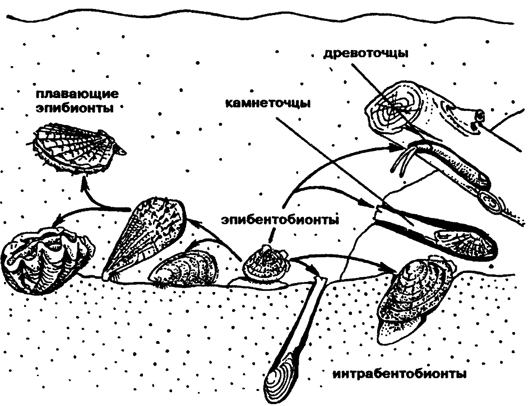
The transition from Protobranchia to Autobranchia is associated with adaptation to a sessile lifestyle, with the formation of a byssal attachment. Labial palps are replaced by filtration gill apparatus. In this regard, the development of siphons and the complication of the stomach (crystalline stalk) are associated. Autobranchia enhanced the water propulsion apparatus, and this led to the formation of septiobranchia. They went from filtering to predation. This led to complications in the stomach. From byssal attachment they switched to a mobile lifestyle.
The ecological radiation of the class is reflected in Figure 232. The central group of bivalves is represented by benthic, semi-surface and weakly burrowing forms (such as Nuculana), from which two main paths of specialization can be traced - to attached filter feeders (such as mussels, oysters) and to burrowing forms with long siphons, among which the most wood borers and stone borers are highly specialized. Fixed forms exhibit particularly great diversity. Some of them are attached to the ground by a byssus and are located with the ventral side down (mussel). Others settle on the soft ground with the pointed top of the shell down, like a Pinna, and their valves stick out with the ventral side up. Heavy tridacnids lie on their backs, with their valves slightly open. Most immobile bivalves lie either on the right valve, like a scallop (Pecten), or on the left valve, like an oyster (Ostrea). Thus, among the bivalves, all possible ways attachment and position of the body on the ground.
Among bivalves, there are examples of overcoming immobility and demonstrating the ability to swim. Thus, a scallop lying on the bottom on one of the valves can float up, flapping the valves and shooting water from the shell cutouts on the sides of the lock. It's like jet propulsion. There are commensal bivalves that cohabit with other animals.
In the process of evolution, there was also a change in food types. Originally bivalves were detritivorous collectors, collecting food particles using oral lobes. Most bivalves specialized in biofiltration, carried out using filamentous or lamellar gills.
What else to read
THE LAST NOTES
- Notification of changes in the terms of the employment contract and transition to an effective contract Notification of the employee about the introduction of an effective contract
- Liquid buckwheat porridge - benefits in every spoon
- Step-by-step photo recipe for freezing vegetables for borscht for the winter at home Freezing borscht for the winter with beets
- Information support for small businesses Types of state support for small businesses
- Snow Maiden Russian folk tale
